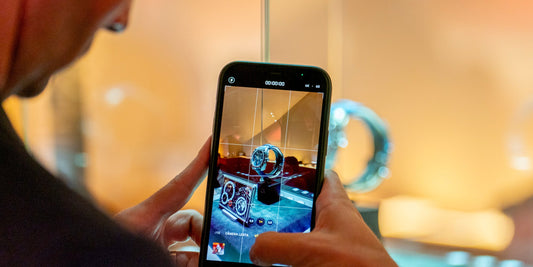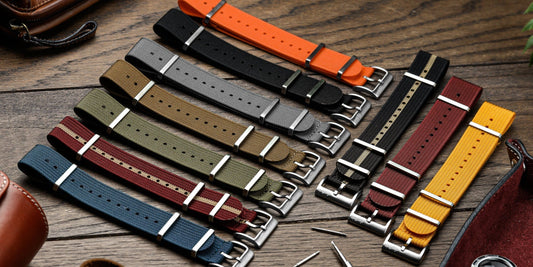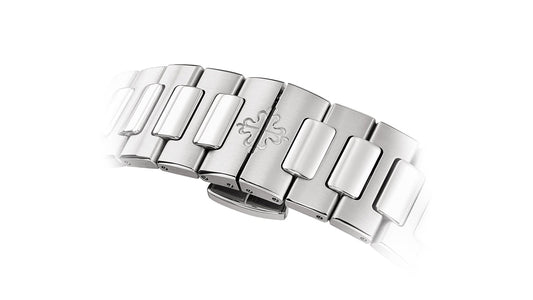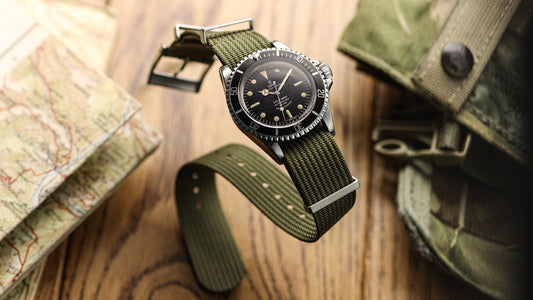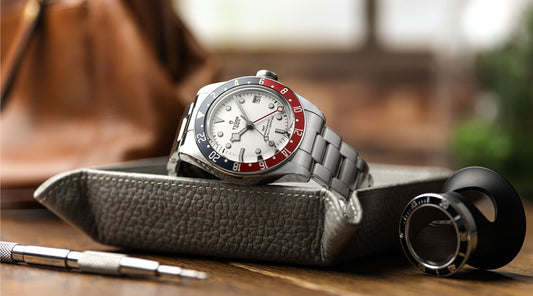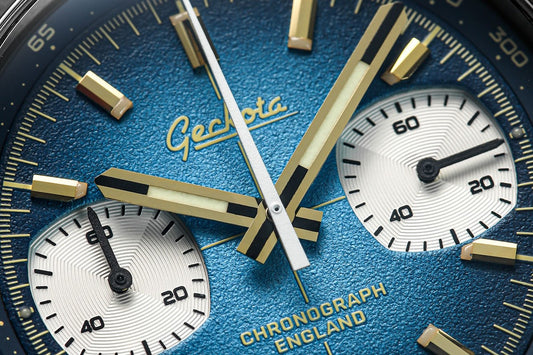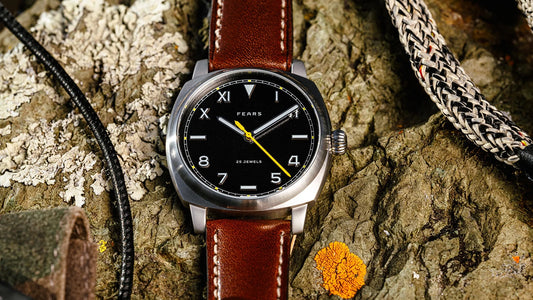My brief this month? To write about a watch that I like but don’t own. There’s a challenge if ever there was one. During my watch education over the last 18 months....
I’ve encountered so many fascinating watches – I’m sure you understand my dilemma…
Of the watches on my shortlist for the future, for divers it’s Omega’s Seamaster 300 2535.80.00 with GMT. Racing chronographs? Probably an Autavia or Carrera. Field watches? Maybe Hamilton’s Khaki… But for this article, my watch is aviation-related to reflect my lifelong interest in flight. It’s Swiss, genuinely iconic and has a long history too. And it’s still in production, with strong visual and historical links to the original. Oh yes, it’s also a mechanical chronograph.
My watch choice is the Breitling Navitimer, launched in 1952. This post-war classic has evolved ever since and was recently updated with a rattrapante complication (‘the ultimate mechanical chronograph’) for Baselworld 2017 – just before CVC Capital Partners bought Breitling…

Navitimer – Breitling’s defining watch?
Breitling was founded in 1884 in St-Imier, Switzerland. Soon, the company’s flair for technical watches, and the dawn of aviation, led to the strong association with flight and flyers that’s defined Breitling ever since, much as motorsport defined Heuer.
Three-quarters of a century later, in the early 1950s, Breitling was growing with the post-WW2 boom in aviation. The watchmakers then launched what was to become their most iconic timepiece. The Navitimer is arguably the wristwatch that’s defined the brand ever since. The Navitimer’s ‘optimised calculating capabilities’ are manifest as a miniature circular slide rule. This evolved from 1941’s Breitling Chronomat and the many other on-board and wrist-worn aviation chronographs that Breitling developed during the 1930s. Interestingly, during this period, Breitling launched their more modestly priced – and therefore more accessible – Montbrillant 12. As Willy Breitling is quoted in Breitling The Book (2009): ‘The low-priced chronograph is intended to cultivate the general public’s taste for accuracy. Popularising the chronograph among young people will have felicitous effects…’
Over 80 years later, Breitling holds 25% of the premium segment in Switzerland (shared with Chopard, Longines and Tissot). It’s interesting to note (EuropaStar Time.Business Chapter 3 2017) that at SIHH and Baselworld 2017, ‘most of the brands…pushed their launches at the entry price level of the brand.’ What goes around …
The evolution of the Chronomat
Nowadays, the Navitimer is promoted by high-paid celebrity brand ambassadors such as John Travolta. However, in the 1950s, Breitlings sold on the reputation of their wartime association with the RAF. And of course, the reputation of the now legendary 1941 Chronomat (CHRONOgraph for MAThematicians). The Chronomat was 1942’s ‘killer app’, with its Venus 175 caliber and soccer-friendly 45-minute timer. And the patented circular slide rule that allowed performance of all tachometer, range-finding and pulsometer calculations. In each case, regardless of order of magnitude of factors used or length of observation.
A ‘smart watch’ for the 1940s
At the time, this was as innovative as today’s smart watches. It completely justified the description, ‘Une création sensationelle!’ in contemporary advertising where G. Léon Breitling S.A. proudly boasted how Chronomat users could quickly and easily solve mathematical problems in diverse scientific and technical domains. A decade later the world was rebuilding, propellor-powered commercial aviation was in its golden age, the jet era had begun and recreational aviation started to boom. Simultaneously, chronographs' popularity followed Willy Breitling’s prediction. In the post-war period, they grew to unprecedented levels alongside Breitling’s presence in on-board instrumentation. The Navitimer Years had arrived….
Breitling’s ‘wrist instrument’
Building on the Chronomat’s success, 1952’s Navitimer was Breitling’s ‘wrist instrument’ and the watch that quickly became its most iconic. According to many Breitling experts, the 1950s and 1960s were Breitling's heyday and the time of their most desirable watches – before they became something of a cliché rich-man’s accessory and inspired so many lookalikes…

Marcel Robert was the genius watchmaker who worked with Willy Breitling to optimise the already successful Chronomat. It was his inspired inversion of the Navitimer’s outer slide rule scale that simplified use. It also made complete calculations possible without repeatedly having to turn the bezel.
Adding three distance-related marks to the inner scale enhanced the watch’s value to aviators. There was STAT for statutory miles, NAUT for nautical miles and KM for kilometres. Along with other refinements, these meant the Navitimer could quickly, easily complete all a pilot’s pre-flight and in-flight navigation calculations. This explains the portmanteau name ‘Navitimer’ for a watch that now sits in the pantheon of iconic post-war chronographs.
Fulfilling a real need in the 1950s
As well as offering genuine practicality and filling a real need, the Navitimer had distinctive looks and massive novelty (in the product design and marketing sense). It was an object that, quoting Del Coates in Watches Tell More Than Time, has the ‘…ability to grab our attention, hold it and start the aesthetic juices flowing’.
Undoubtedly, the Navitimer retains the wow factor that engaged luxury watch buyers in the 1950s.Viewed with nearly 70 years’ hindsight, it’s clear how Navitimer characterises functional design that improves pilots’ efficiency – albeit in a ‘high-information’, ‘high shape variation’ way. The Navitimer may seem more ‘complex’ and ‘complicated’ (informationally as well as horologically) to laypeople. But that only enhances its appeal to certain buyers. After all, this tool is actually very familiar to anyone used to flight decks. Therein lies more of the Navitimer’s appeal for aviation enthusiasts.
A pleasing elegance (in a technical way)
At the same time, the Navitimer possesses a pleasing elegance (in a technical way) from its case detailing, and tapering strap attachments. There’s the contrast between its high-tech metal and a luxurious black or brown leather strap too. And then there’s its black dial with high-contrast markings. Finally, yet importantly, there’s the famous ‘Navitimer whirl’ as the inverted logarithmic scales apparently accelerate during rotation of the bezel. Navitimer was the aviation watch that won endorsement as Official Timepiece of the Aircraft Owners’ and Pilots’ Association (AOPA). Later, with Breitling branded ‘official supplier to world aviation’, Navitimer's technical performance, image, personality and reputation grew further.
The heyday of the Navitimer – and aviation watches
The heyday of the Navitimer came just before electronic and satellite navigation aids made wristwatches, and even traditional E-6B circular flight computers, redundant for anything but basic pilot training. Nowadays, the slide rule and chronograph functions make this another example of the modern wristwatch as anachronism. In fact, the Navitimer perfectly demonstrates a wristwatch as the ‘multivalent and semiotically charged object’ referenced by Peter Oakley in ‘Ticking Boxes: (Re)Constructing the Wristwatch as a Luxury Object’ (Luxury, 2:1, 41-60, 2015).

Demonstrating luxury watches’ fundamental irony
In a digital age where timing and calculating is so easy with digital technology, the Navitimer is arguably one of the best exemplars of luxury watches’ fundamental irony – that, despite their bewildering capabilities, most of these abilities are rarely, if ever, used by wearers!
Instead, the twenty-first century Navitimer makes a high-visibility statement about someone’s ability to afford such luxury. Equally, it enables the wearer to demonstrate their affinity with aviation. It’s an enduring reminder of when test pilots pushed jet and rocket-powered aircraft to the limits of high-speed flight and the Cold War held the world in thrall. It was an age when man set his sights on space, jet airliners shrank the world for the masses and Breitling encouraged every self-respecting pilot to sport a Navitimer.
Swiss engineering and aviation associations
I’m not a bling fan. For me, Navitimer’s appeal is in how it exemplifies Swiss engineering expertise and its association with aviation history – not as a status symbol to flash on my wrist! I like the functionality too, even if it is a bit fiddly to use. And, yes, I can work the circular slide rules on my Citizen Eco Drive GMT BJ7070 57E and Seiko SNA411.
I respect the Navitimer’s authenticity. Look beyond the ‘big flashy watch’ label and Navitimer has undeniably earned its iconic status. There’s the way form follows function with very little unnecessary embellishment too. And Breitling’s long history as specialists in chronographs and core members of the Swiss luxury watch establishment…

Genuine iconic functionality and elegance
If I eventually buy a Navitimer (you can find a nice 1960s Ref 806 for around £3k) it will be for its historical significance, technical capability and that authentic association with aviation’s golden age. As someone who can recall looking up at Vulcan V-bombers and Boeing 707s in the early 1960s, the combination of genuinely iconic functionality, Swiss quality, elegance, and historic significance is very seductive.
I also like the idea of a watch that, whether you love its functional significance or the statement it makes, is a refreshing collectors’ alternative to Rolex. Of course, a nice GMT-Master would also capture the jet-setting, Frank Abagnale, Catch Me If You Can vibe well. (Even if Leonardo DiCaprio, a TAG Heuer brand ambassador, wore a Carrera in the movie!)
Apparently, Navitimers (especially pre-1979) are surprisingly collectable, yet often overlooked due to preoccupations with Rolex. That’s a shame when the Navitimer has played such a key role in Breitling’s pilot chronograph innovation. And before Omega Speedmaster fans start reminding me of their ‘been to the moon’ claims, please remember that on 24 May 1962, Lt. Commander Scott Carpenter orbited the earth in Aurora 7 – wearing a Breitling Navitimer Cosmonaute…
Old Navitimer or Navitimer World?
A Navitimer Rattrapante would undoubtedly be a fun measure of how far the range has come. And have more complications than ever to play with as I imagined doing pre-flight checks on a 1950s Constellation... More realistically, I think a 42mm Old Navitimer A13322 or a 46mm Navitimer 01 could tempt me. Alternatively, given my liking for GMTs, maybe the 46mm-diameter Navitimer World A24322…

The epitome of bold gutsy design and innovation
Since 1884, Breitling has helped define how modern chronographs – and arguably modern watches – look. They’ve done it with bold, gutsy designs and unique ideas too. Not least, giving 1950s aviation its ‘smart watch’ in the form of the original Navitimer – the epitome of what bold design and innovation should be. Old or new, I’d love one, with all the history and aviation associations that brings. One day, I think, I’ll probably make a Navitimer mine!
Do you have a pilot chronograph itch that you want to scratch? Do you think Geckota should add a Navitimer-style watch to its range? Tell them what you think – and check out their range of vintage pilot chronographs here…



